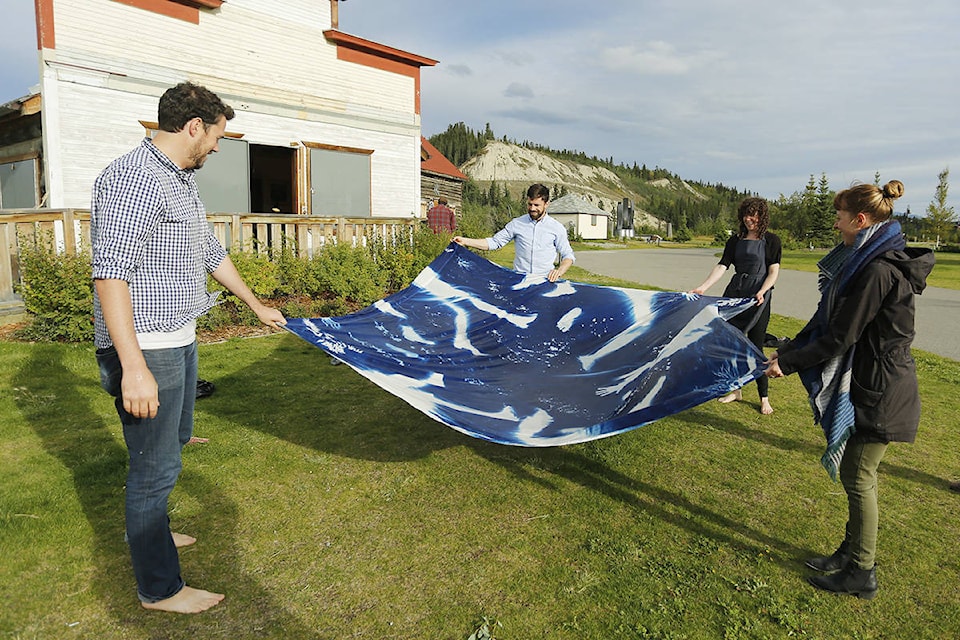Stiff, navy-blue sheets of watercolour paper are hanging from a clothesline inside Shipyards Park’s Jenni House. On each of them, an object is imprinted in stark white relief — leaves with veins, stems and jagged edges clearly defined on one sheet; a twig with leaves and what could be flowers or buds poking out on another.
The work of local artist Chelsea Jeffery, who’s completing the Yukon Arts Centre’s Jenni House Residency this summer, the prints were created via a method called cyanotype, which involves mixing two chemicals — ammonium iron(III) citrate and potassium ferricyanide — to create a light-sensitive solution. The solution can then be painted on paper or fabric. When an object is put on top and the medium is exposed to sunlight, the subsequent reaction turns the uncovered areas blue while leaving the parts covered by the object the original colour of the paper or fabric.
“It’s really just applying objects to a sensitized surface and then capturing something of their physical form in the finished product, which I find really interesting,” Jeffery said, who did her largest cyanotype to date on Aug. 28 — a roughly three-metre-by-three-metre print that enlisted the help of a handful of people who laid down on the treated fabric in Shipyards Park for over 30 minutes.
Originally a printmaker who worked in historical photo curation while living in Toronto, Jeffery’s background in women’s studies and the history of photography led her to discover the work of Anna Atkins, a 19th century English botanist who’s widely cited as being the first female photographer and whose book, Photographs of British Algae: Cyanotype Impressions, published in 1843, is widely considered the first book to be illustrated with photos.
Although she knew about cyanotype’s historical significance — it was also used by engineers and architects to duplicate designs, which is where “blue print” came from — Jeffery said she never tried it herself until she moved to Whitehorse two and a half years ago.
“When I moved here, (I) didn’t really have access to a letterpress which I loved, so I was like, ‘What else can I do?’ So although this is very different from letterpress printing, I kind of see this as a form of relief printing, so using the surface of an object to create a printed image,” she said.
Along with her interest in botany and plant identification, Jeffery said she was drawn to cyanotype because of the unique process, one that straddles both photography and printmaking.
“I was really intrigued by the chemical process that it involves, it’s a very beautiful process to me. I enjoy mixing the chemicals, I enjoy applying the emulsion to the paper, I really enjoy exposing it to the sun and then kind of seeing the result as you rinse it,” she said.
The making of a cyanotype is somewhat of an art in itself, an evolving series of gentle colours that lead up to the final, bold print. When first applied to paper, the solution takes on a greenish-yellow colour that looks more like a stain than paint. Once exposed to the sun — typically, Jeffery places the treated paper and objects between two sheets of glass and hold them tightly together with binder clamps — the exposed parts of the paper gradually start to turn brown-grey. Depending on how sunny it is, a print typically sits out for 15 to 20 minutes until Jeffery retrieves it and dunks it into a tub of water, where yet another transformation happens; as the water turns yellow, the parts of the print exposed to the sun suddenly turn a deep, dark blue, while the covered fade from an electric greenish-yellow to white. After swirling it around to get the remaining chemicals out, Jeffery washes the print under running water before hanging it up to dry.
Although the majority of her prints so far have been of plants, Jeffery recently started experimenting with making prints of litter. Hanging between two recent prints of leaves and flowers on her Jenni House clothesline were pieces featuring cigarette packages and butts, straw wrappers, a muffin liner and cough drop wrappers. It felt like a natural next step for what Jeffery sees as a medium meant to document what’s immediately in the world around her.
“I would say that our natural world also now includes garbage…” Jeffery said. “I feel like if I were to only select beautiful plants to make prints of, then I’m not really sampling from my environment accurately.”
Contact Jackie Hong at jackie.hong@yukon-news.com
